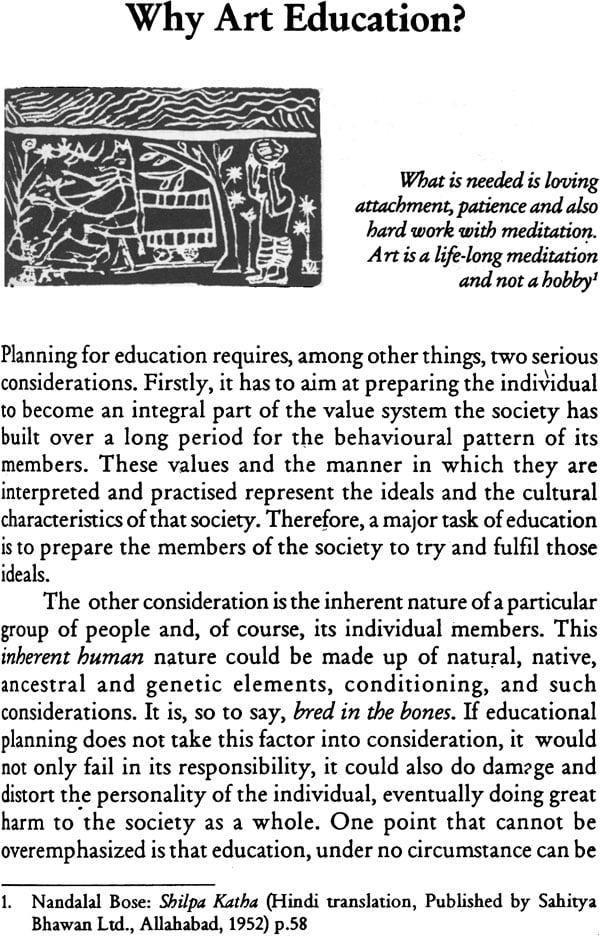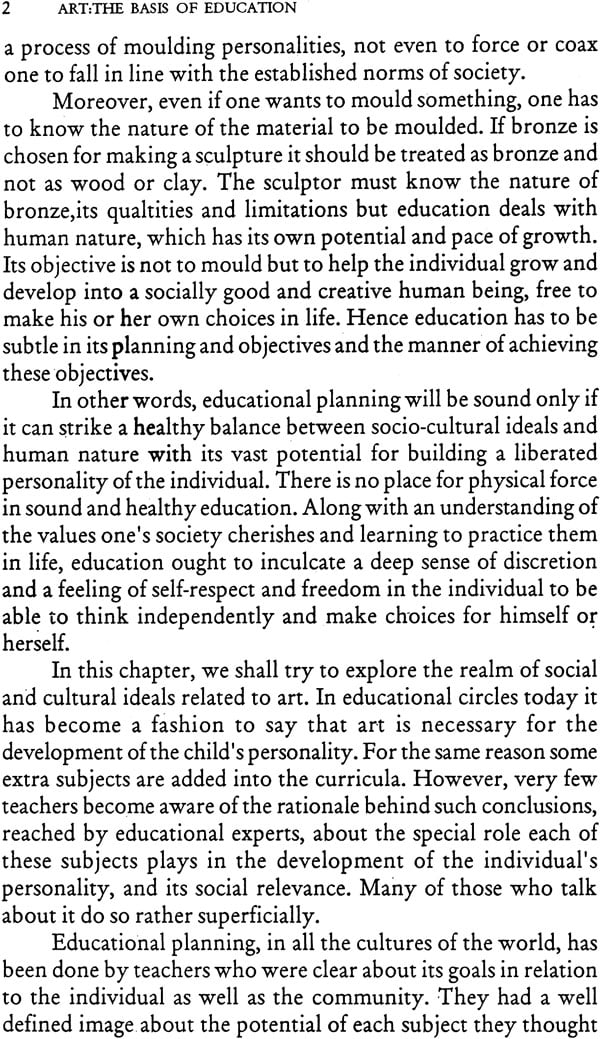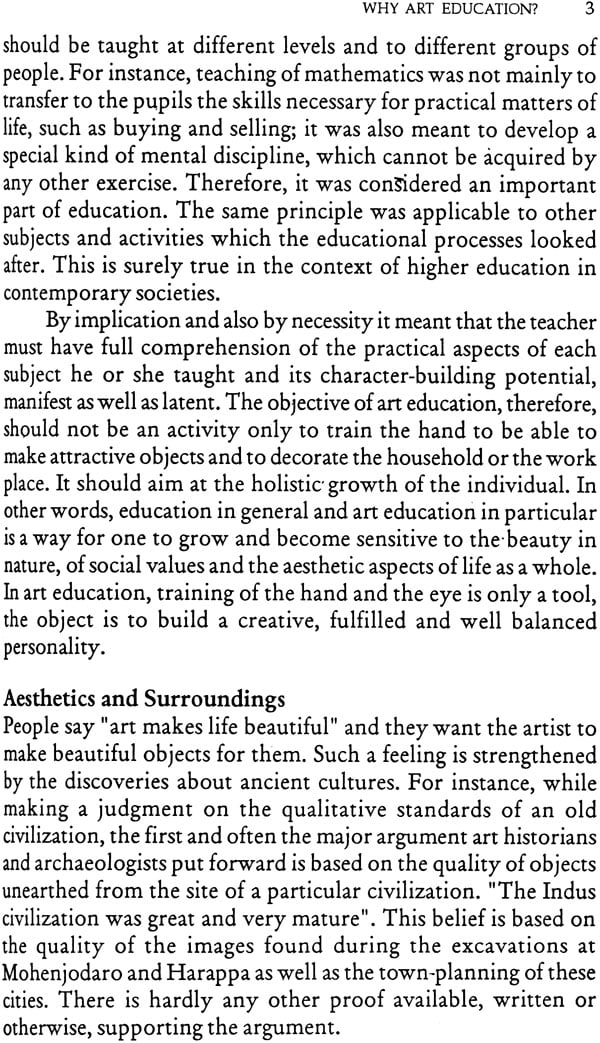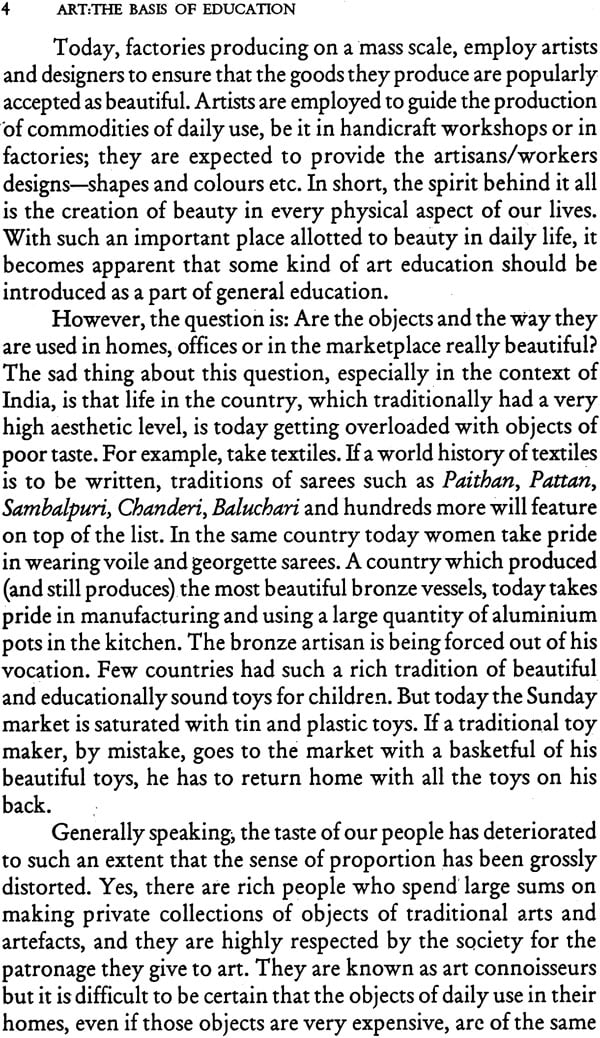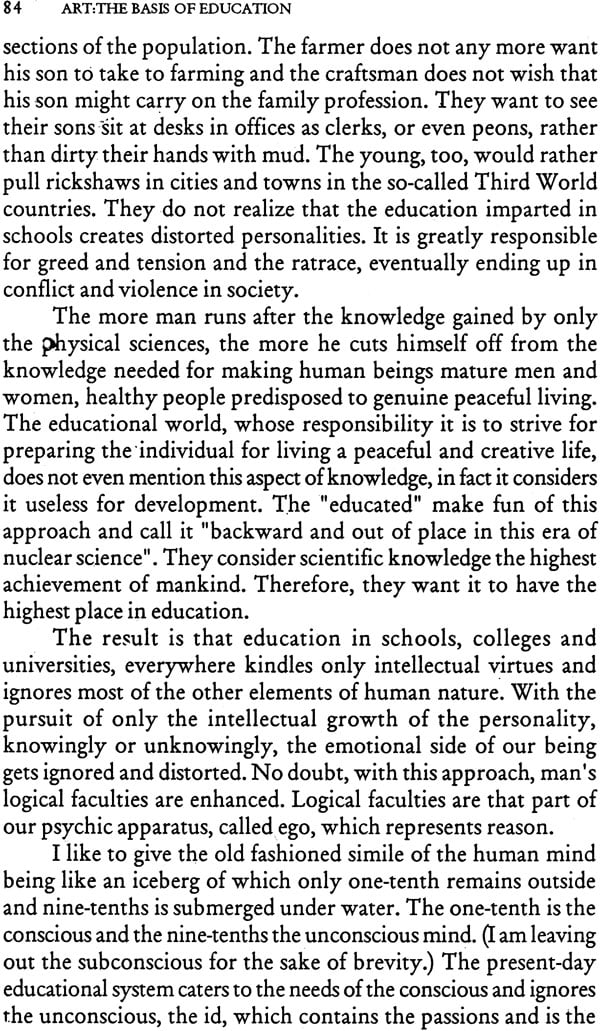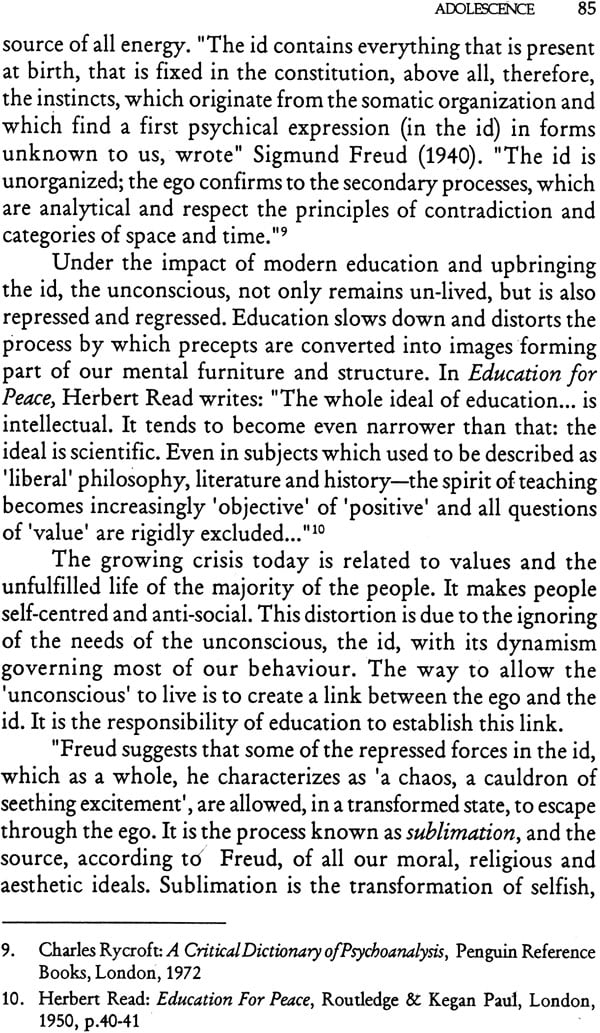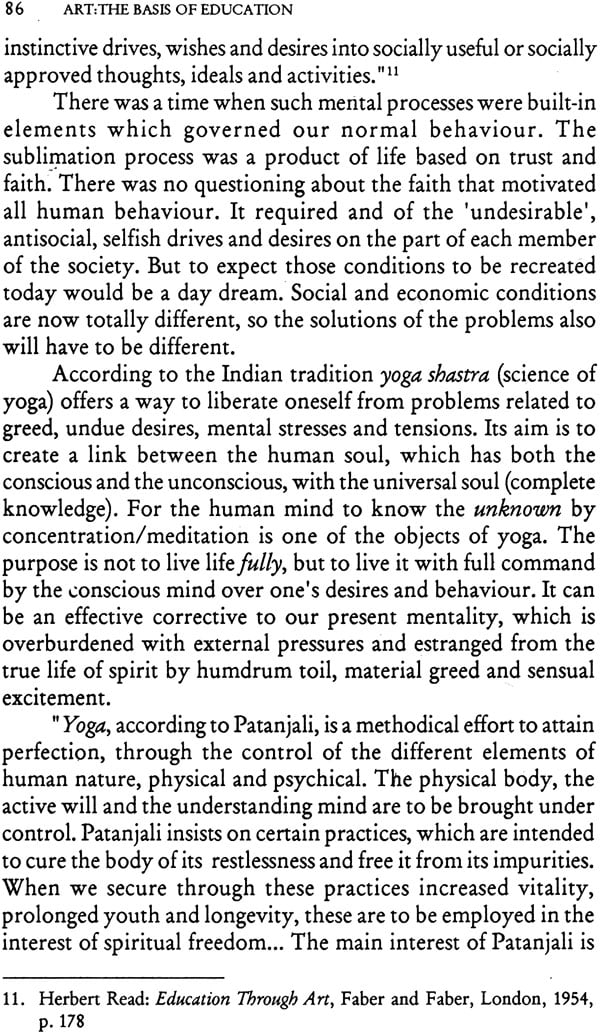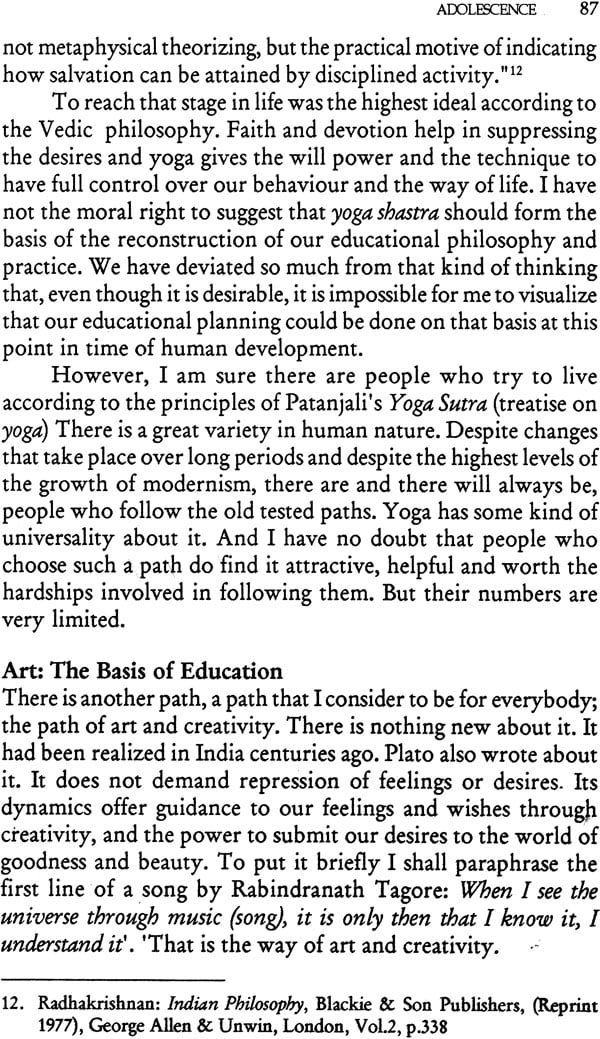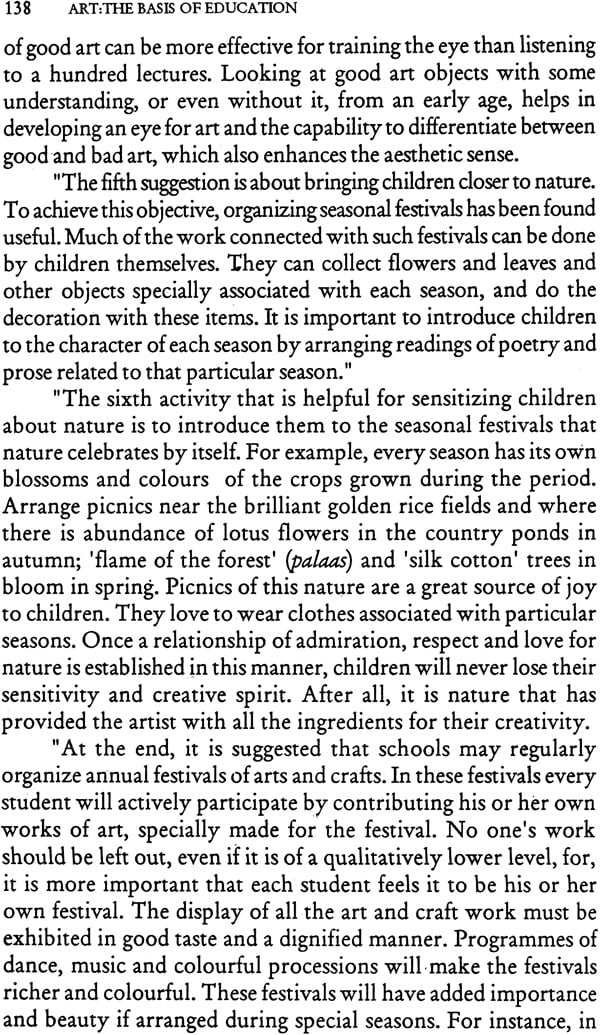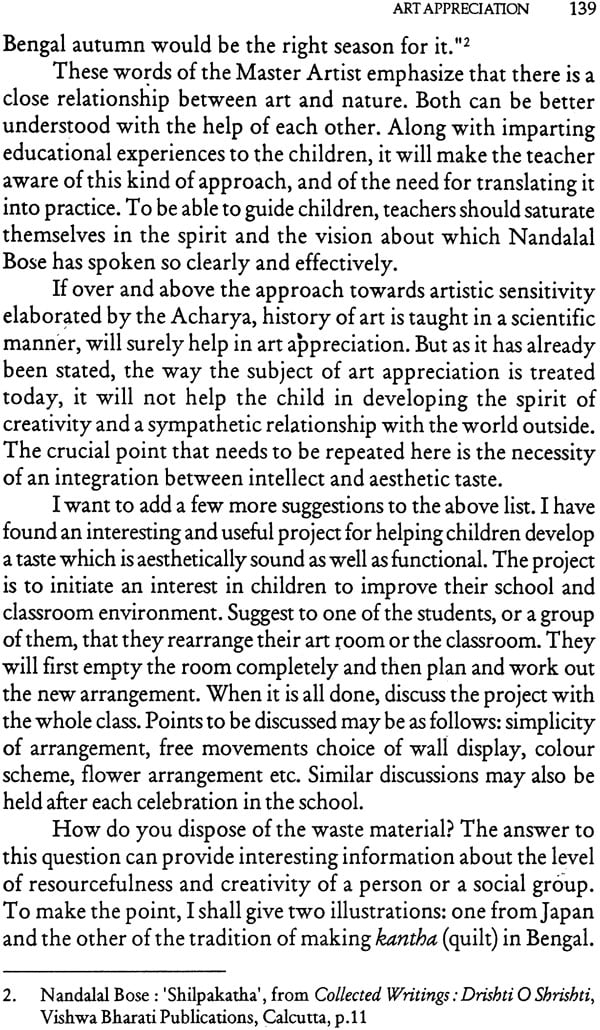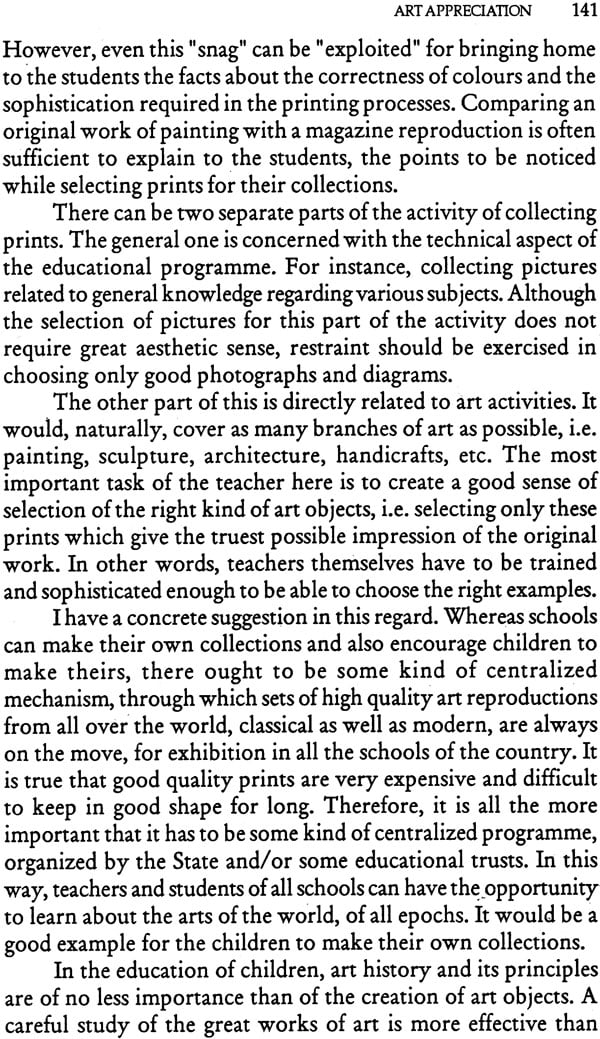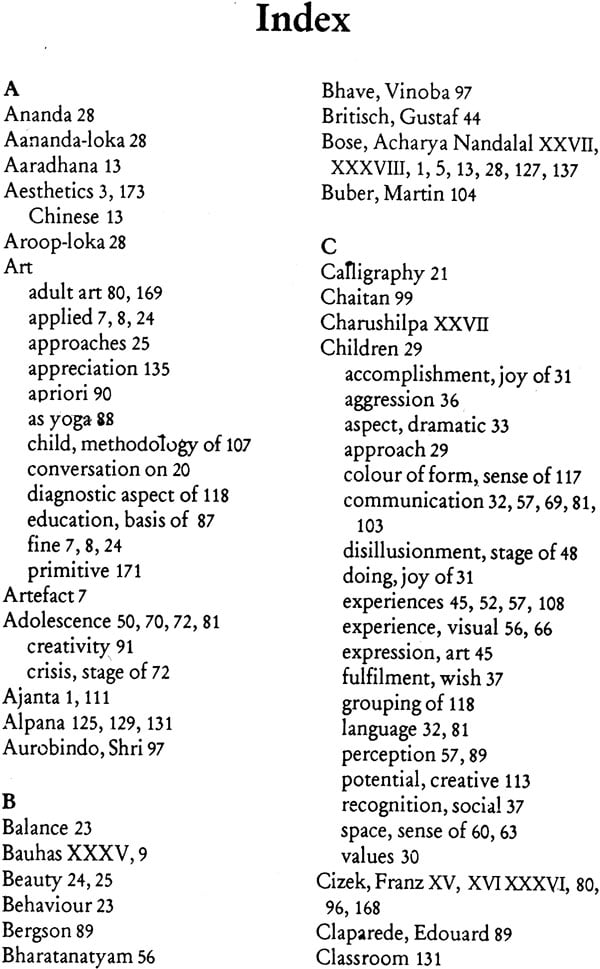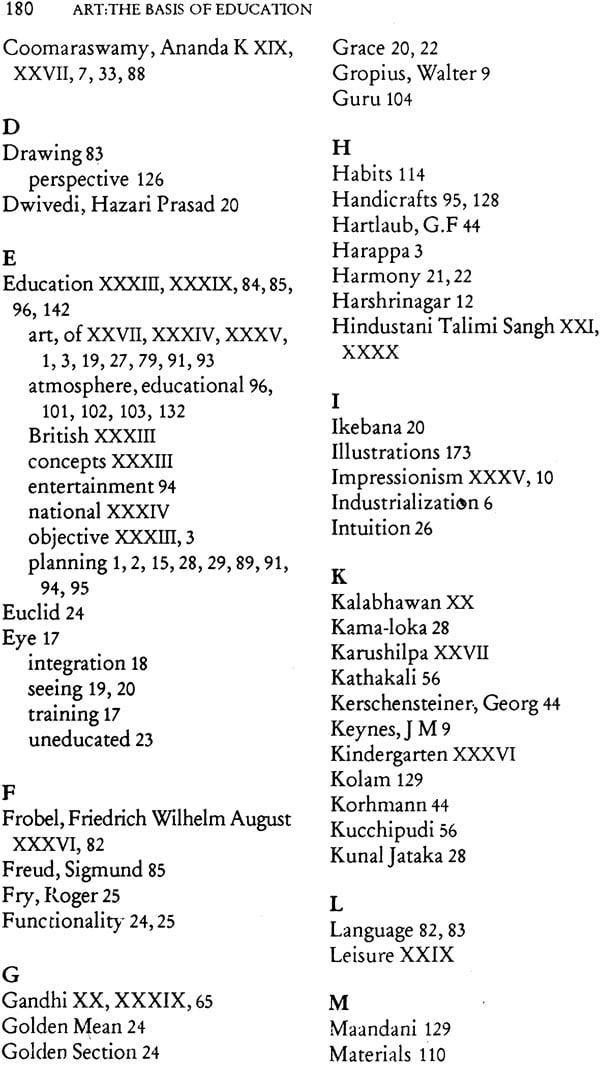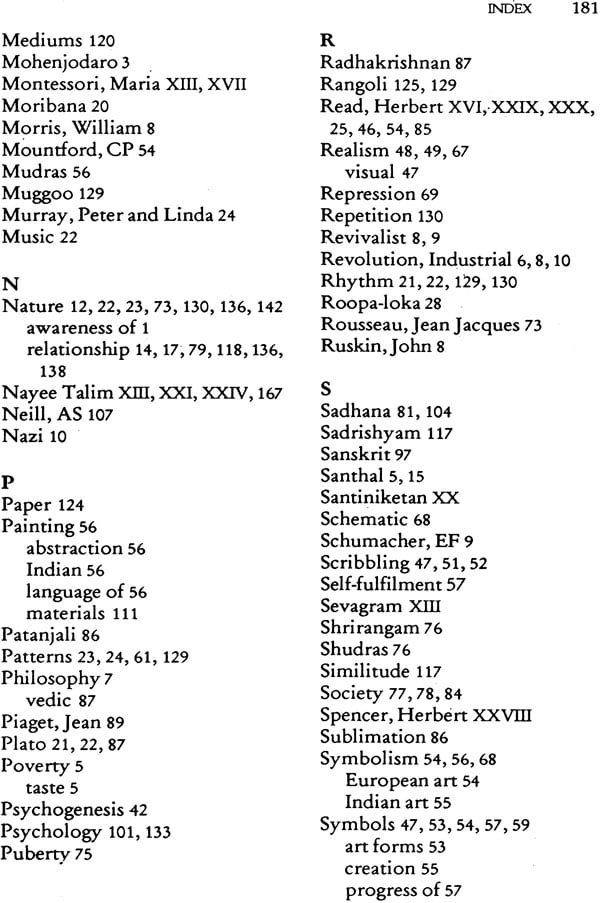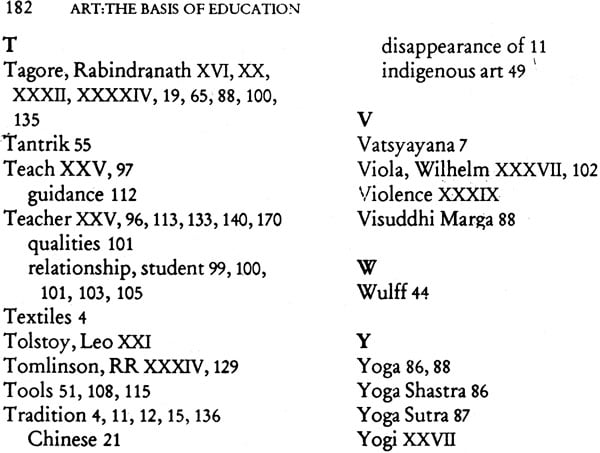
Art: The Basis of Education
Book Specification
| Item Code: | IDG302 |
| Author: | Devi Prasad |
| Publisher: | National Book Trust, India |
| Language: | English |
| Edition: | 2006 |
| ISBN: | 8123723148 |
| Pages: | 230 (B & W Illus: 8, Color Illus: 55) |
| Cover: | Paperback |
| Other Details | 8.5"X5.5" |
| Weight | 330 gm |
Book Description
About the Book:
Based on the author's experience with children and teachers as a teacher of art at the Nayee Talim Educational Institute, Gandhiji's ashram, Sevagram, the book is a pioneering study enunciating the essentiality of art as the basis of education. Emphasizing the need for the development of an all round personality and the function of art expression therein, the book takes a detailed look into the importance of art, stages of its expression in a child, its importance in shaping the individual's thinking and cognitive faculty, the role of teachers and parents and most importantly its role in an angst-ridden society.
About the Author:
Educationist and artist, Devi Prasad graduated from Rabindranath Tagore's school at Santiniketan. A non-violent activist, he joined the War Resisters' International, London as its Secretary General and later, Chairman. He has taught at various universities including Viswa Bharati. Widely travelled, Devi Prasad has many publications including Gramdan: the Land Revolution of India, They Love It. But Leave It-American Deserters, Peace Education or Education for Peace in English and Rabindranath Tagore-Shiksha Aur Chithrakala, published by NBT, and Bacchon Ki Kala Aur Shiksha in Hindi. Besides he was the editor of the journal Nayee Talim for several years. He and his wife Dr. Bindu Prasad live in New Delhi.
Blessings:
In Devi's book on art education, he has covered all the aspects of teaching art to children. He has elaborated the technique of art teaching in a natural and beautiful manner. The book also gives an understanding about those children who may develop into artists later in life. Moreover, the author has dealt with the subject of art appreciation by common men and women. Although every man and woman cannot become an artist, it is necessary that there should be arrangements for art education for everyone in society, whichever walk of life he or she may belong to. It is only through such a holistic approach to education that people can understand and sympathize with the joys and sorrows of the artist and artisan and their needs.
Lack of knowledge about art make people lose their mental balance. The atmosphere of tension and conflict in the world is also due to ignorance about the essence and the essentiality of art in life.
Art education is not a product only of reading books or hearing about art. It develops through seeing great examples of art. Still better, if everyone does creative work with his or her own hands, thus understanding it directly.
A comprehensive discourse on all these subjects has been given in Devi Prasad's book. It will benefit artists as well as common men and women.
-Nandalal Bose
Santiniketan
Foreword:
My friend and colleague, Devi Prasad, wrote a book on children's art education and suggested that I write the foreword for it. Whenever I see a book with its foreword written by someone other than its authors, I feel somewhat irritated. A good book stands on its own, so much so that after it has been written, it does not require the support of even its own author. So why should it seek anyone else's support?
I tried this argument with Devi Prasad, though I was saying to myself that it would be good to attach my name to the book, which has come out of his deep experience. Actually, he had not to do much arguing to persuade me. I accepted his request and agreed to write the foreword to the book, although I admit that at that time I had not yet read the manuscript. That is because I believe that you can estimate the quality of the work if the author is personally known to you.
I have known Devi Prasad for nearly sixteen years. We were colleagues in Hindustani Talimi Sangh". I have had the opportunity of seeing his work as well as seeing him work. I have also seen the work of his pupils. Devi Prasad's personality is identical to the image I have of a good teacher. I cannot fully describe the kind of respect I have for a true teacher. It was on account of this feeling that I wished my name to be associated with his book. Good company always benefits. I have seen the dying glory of a personality being revived. Nothing is quite like the company of a good teacher.
I accepted his request for the sake of such company, and thinking that I should write down some of my thoughts on children's art education, thus securing a little corner for myself in this book. Then I read the book, word by word. It changed my thoughts, when I found that the book contained much more that I had known about this subject. By adding the feeling of love to his experiences, the author has not only made ideas more bright and attractive, he has also put much warmth in them. This book clearly reflects the writer's years of experience, much imagination and genuine love for children. It is a book that should be read by all teachers, not only by art teachers.
The kind of art this book deals with is not that which is taught two or three days a week in classes of an hour or so. It is that art which is a lifelong discipline-a "sadhana". The author has experience of Tagore's world as well as Gandhi's and has the courage of putting life into art and transforming life into an art. Being a true teacher, Devi Prasad believes in the path of love. Such a perspective has opened for him the windows into the child's life. He has put forward a healthy perspective regarding the child-teacher relationship. Teachers who want to understand this book. It will also remove the confusion about the hierarchical status of different arts especially fine arts and applied arts, and will begin to build links between life and art. It will remind teachers that the artist and the teachers are both yogis. It will make them ask themselves why they are going astray from this yoga-sadhana. This book will make them understand the child and also the crises of adolescence. It will also indicate the means to understand social problems. Society today has itself become stagnant, in an adolescent crisis from which it is unable to emerge.
In our country, only those people write on education who do not like to be teachers. Thank goodness that the trend is changing, and as an old tired teacher, I feel proud that an Indian teacher has written such an enlightening book that gives a feeling of warmth to our colleagues in the teaching world. I hope the teacher who studies this book will gain more understanding and courage to continue his work with the conviction that life is a work of art. I wholeheartedly thank Devi Prasad for giving me the opportunity of reading this book before anyone else.
-ZAKIR HUSSAIN
I had my primary education in a school which was a typical example of one of the most anti-education educational systems created by colonial rule in nineteenth century India. The most vivid memory I have of that period is that for some reason or another, or perhaps for no reason at all, our teachers never hesitated to give us corporal punishment, which made us hate the school. There was nothing in the school that could create in us an interest in any subject or activity. I do not remember enjoying even a moment of my time in it. Later I was moved to the primary section of an intermediate college founded on the Aryasamaj ideals. Luckily this school had a carpentry class as an extracurricular activity.
The family moved to a new house situated in open and better surroundings. The new place was partly renovated before we moved in and partly afterwards. I was almost nine at the time and was fascinated by the work the craftsmen were doing. Both the head mason and the carpenter, were very good craftsmen and tolerant people. They did not mind my sitting and watching them work and meddling with their tools. This experience was enough for me to take an interest in carpentry at school. So much so, that I gradually collected enough tools of my own, bought with my pocket money, to be able to make things for the house. I also became interested in keeping the wood work of the house- especially the doors and windows-clean and well painted. Later I even became interested in drawing and painting, a subject which I took for my college education after finishing school.
In spite of a boring, nay hateful, primary education I think I had a. more or less happy childhood although I was not conscious of it at the time. It only became clear to me, during my student days in the art college at Santiniketan, when I saw the happy faces of the ashram school-children and later when I did my teaching/ research work as a part of the educational scheme initiated and guided by Gandhiji in Sevagram. I realized that if during my childhood I had not had the opportunity to "meddle" with the tools and the raw materials of the craftsmen who renovated our house, I would not have developed the taste for "making things"! Without this experience would I have understood children's nature, as I think I did in later life, I often wonder!
The principles of education worked out by Tagore had totally rejected the notion and practice of teaching based on textbooks. For Tagore, education was a process of learning rather than a mechanical method of thrusting information into, what are supposed to be, the empty minds of children and adults. According to Tagore, the best textbook is life itself, and nature, of which we are an integral part; so also our cultural heritage and its significance in the ongoing processes of our lives. To put it in a nutshell, there are three centres of education: mother-tongue, nature and creative activities. The system of education the colonial rulers had developed in India not only ignored these elements, it totally ruled out their place in the processes of education at all levels.
Looking at the lives and expressions of the children of the Sishu-Vibhag (pre-school) and Patha-Bhawan (primary school) of Santiniketan, and spending some time with them, I understood that the school can and must be a place of joy and creativity. My art education in Kalabhawan (art college) under Acharya Nandalal Bose and Acharya Binod Behari Mukherjee enhanced my understanding of this truth. That was the inspiration and strength behind my experiments with child-art in the Sevagram educational institute.
I was fairly well aware of Gandhi's ideas on art, He was closer to Tolstoy than to Tagore-a bit too puritanical for someone like me, who had experienced life as a young artist in an atmosphere created and nurtured by Tagore. Tagore believed that for a healthy development of personality and human relationships, bread and art are inseparable aspects of life. Tagore and Gandhi were aware of their so-called differences. Yet they were very close to each other on all matters of consequence, the truth of which I continuously realized in my life.
Within a few months of my graduation from Santiniketan I joined the team working for the development of Nayee Talim ("new education" as it was named by Mahatma Gandhi himself in its second and the final stage). Initially I took up the job for six months. It was for the duration of the teachers' training camp organized by Hindustani Talimi Sangh (the organization founded in 1937 for carrying out the Nayee Talim scheme) to start work along the lines of the thinking Gandhiji had come to during his last imprisonment. He was released in early May, 1944. A basic school was already functioning in Sevagram since 1937, when the Gandhian education scheme for children between seven and fourteen years of age was first launched.
This was the beginning of the second phase of Nayee Talim. Explaining his scheme to the Hindustani Talimi Sangh Conference held in Sevagram in January, 1945 Gandhiji said:
"Although we have been working for Nayee Talim all these years, we have so far been, as it were, sailing in an inland sea which is comparatively safer. We are now leaving the shores and heading for the open sea. So far, our course was mapped out. We have now before us uncharted waters, with the Pole Star as our only guide and protection. That Pole Star is village handicrafts."
"Our sphere of work now is not confined to Nayee Talim of children from seven to fourteen years: it is to cover the whole of life from the moment of conception to the moment of death. He was very clear that this new line of action was going to take all our energy and dedication. Even as a fresher in the field I had realized almost from the very beginning that it was probably going to be very tough, but it was the greatest and most rev9lutionary experiment in educational planning for our country.
It was my good luck that I had my college education in Tagore's Santiniketan. Our two seniormost colleagues E.W. Aryanayakam and Asha Devi Aryanayakam also had been close associates of Tagore. Asha Devi took a keen interest in my experiments and supported me throughout. She also encouraged me to write occasional articles for publication in the institute's official journal Nayee Talim, which, by the way, helped me in working out the plan of this book.
I became convinced that the experiments I was going to conduct should fully incorporate, in a balanced and integrated manner, the educational principles propagated by both Gandhi and Tagore. It may be worth mentioning here that the first syllabus-for teaching art in Basic Education-as Nayee Talim was called -in 1937, was prepared with the help of Acharya Nandalal Bose. It was a take-off point for me, but only a take- off point.
Although they were inspired by the Gandhian spirit and the spirit of experimenting with the principles of Nayee Talim, most of our colleagues had no clear notions about the place of art in the processes of education. Art to them was some kind of skill or a collection of skills to decorate various aspects of life or painting pictures, making sculptures, etc. for so-called public education or propaganda, or producing different kinds of functional artefacts. As a "specialist" in the field and one who was trying to discover a much wider role that art could play in the development of the full personality of the child, I had to face various problems, practical as well as theoretical. I was in need of clarity 'and support at the same time.
| Foreword | xi |
| Prelude | xiii |
| Preface | xix |
| List of Illustrations | xxxxv |
| Why Art Education? | 1 |
| The Children's Angle | 29 |
| Psychogenesis of Child Art | 42 |
| Adolescence | 72 |
| Adolescence and Creativity | 91 |
| The Teacher and the Educational Atmosphere | 96 |
| Methodology of Child Art | 107 |
| Art Appreciation | 135 |
| Questions and Answers | 143 |
| Appendices | 167 |
| Bibliography | 175 |
| Index | 179 |
